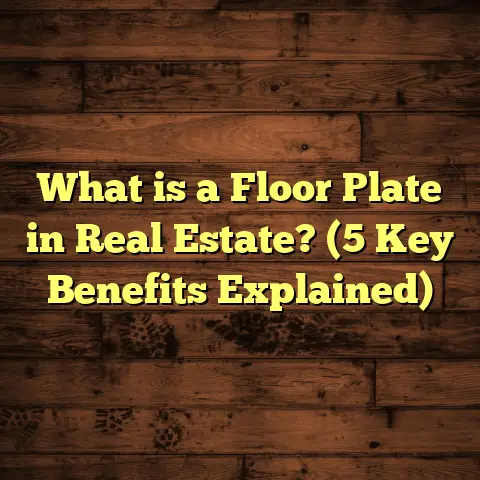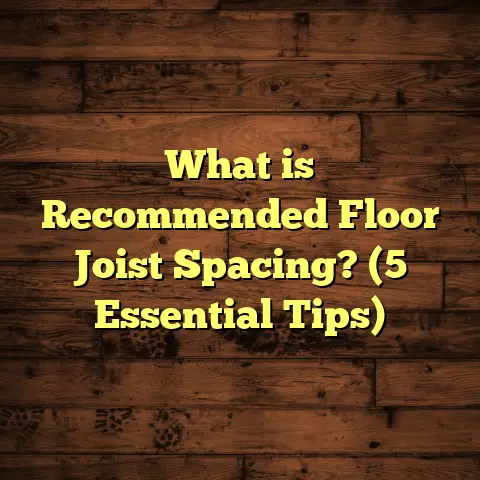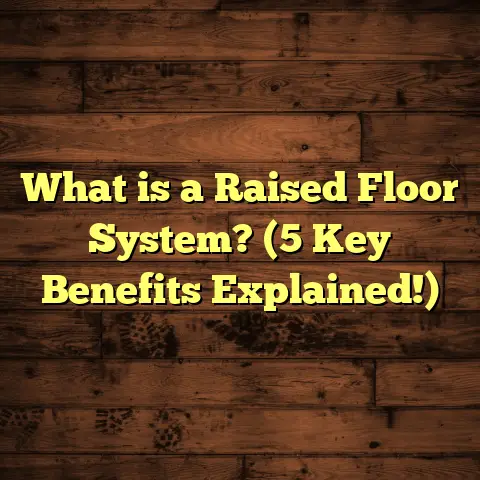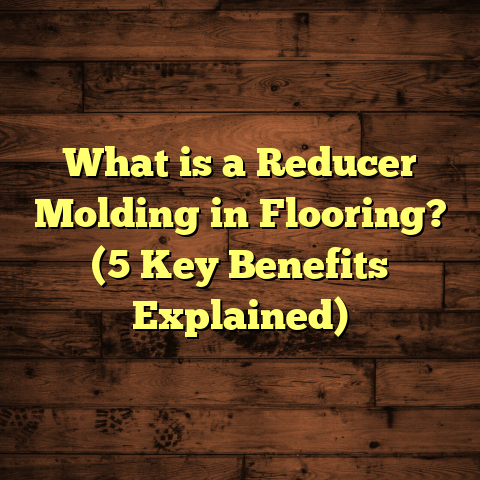What is Non-Slip Vinyl Flooring? (5 Reasons It’s Essential)
When I first started working on flooring projects, I quickly realized how slippery surfaces could be a real hazard, especially in homes with kids or elderly family members. That’s what got me interested in non-slip vinyl flooring—something that offers safety without sacrificing style or durability. If you’re wondering what this flooring is and why it might be a smart choice for your space, I’m here to walk you through everything I’ve learned over the years.
What is Non-Slip Vinyl Flooring?
Non-slip vinyl flooring is a type of flooring designed specifically to reduce the risk of slipping, even when the surface is wet or oily. It’s made from vinyl, a flexible and durable synthetic material, but with added texture or coatings that create grip underfoot. Unlike regular vinyl that can sometimes be slick, non-slip vinyl has features like embossed patterns, grit additives, or special finishes that help improve traction.
This kind of flooring is popular in places where safety is a top priority—think kitchens, bathrooms, hospitals, schools, and commercial spaces. But I’ve found it increasingly used in residential homes too because it strikes the perfect balance between ease of maintenance and slip resistance.
How Does It Work?
The main idea behind non-slip vinyl is increasing friction between the floor and your shoes or bare feet. Manufacturers embed tiny particles or design raised textures that catch your foot instead of letting it slide. The slip resistance is often measured by something called the coefficient of friction (COF). A higher COF means better grip.
To put numbers on it: A COF of 0.5 or above is generally considered safe for commercial settings. Many non-slip vinyl floors have COFs around 0.6 to 0.8, which means you’re less likely to take a spill.
Vinyl itself is made primarily from polyvinyl chloride (PVC), mixed with plasticizers to make it flexible. This base allows for various manufacturing techniques that create different surface textures for safety without compromising comfort.
Why I Believe Non-Slip Vinyl Flooring is Essential
I’ve installed many flooring types over the years, but non-slip vinyl keeps popping up as a favorite for safety-conscious clients—and here’s why:
1. Safety Comes First
Have you ever slipped or seen someone else slip on a wet floor? It’s scary and can lead to serious injuries. Non-slip vinyl flooring dramatically reduces this risk.
In one project I worked on for a daycare center, the client was worried about kids running around on slippery floors. We installed textured non-slip vinyl, and there was a noticeable drop in minor slip incidents reported by staff. It’s not just about peace of mind; it’s about preventing trips and falls that can cause fractures or worse.
According to the National Safety Council, slips and falls account for over 1 million hospital emergency visits annually in the US alone. Having floors that minimize this hazard can save not only money but also health and wellbeing.
But safety isn’t just for high-traffic commercial spaces. In my experience with residential clients—especially families with toddlers or elderly relatives—non-slip floors can literally be life-changing. One client told me how their mother felt confident moving around without needing a walker after installing non-slip vinyl in her bathroom and kitchen.
Understanding Slip Resistance Standards
You might wonder how “non-slip” is defined or tested. There are several standards that manufacturers use:
- ASTM D2047: Tests static coefficient of friction on dry surfaces.
- ASTM F1677: Measures dynamic COF using a standard slider.
- Pendulum Test (BS 7976): Widely used in Europe to measure slip resistance under wet conditions.
Most non-slip vinyl products meet or exceed these standards for commercial or residential use. When selecting flooring, I always check these certifications because they back up manufacturer claims with real data.
2. Durable and Easy to Maintain
One thing I really appreciate about non-slip vinyl is how tough it is. It handles heavy foot traffic without wearing down quickly. Plus, it cleans up easily—no special cleaners needed.
In a restaurant kitchen I helped renovate, the staff was constantly dealing with greasy spills and water on the floor. We installed non-slip vinyl with extra grit additives to give them better footing during busy hours. Years later, the floor still looked good and performed well without needing replacement or extra treatment.
Vinyl is water-resistant by nature, so spills don’t soak in or cause damage like hardwood or carpet might. For anyone juggling a busy household or commercial space, this means less worry about stains or costly repairs.
Another thing I noticed is that non-slip vinyl stands up well to chemicals commonly used in cleaning or industrial environments. This makes it ideal not just for restaurants but also hospitals, labs, and factories.
Cleaning Tips from My Experience
Maintaining slip-resistant surfaces doesn’t mean scrubbing harder—which can sometimes wear down the texture. Instead, gentle cleaning with neutral pH cleaners works best for me. Avoid waxes or oil-based products that can make floors slick again.
Regular sweeping or vacuuming helps remove grit and dirt that could reduce traction over time.
3. Versatility in Design and Installation
You might think safety floors look boring or industrial, but that’s not the case with modern non-slip vinyl. There are tons of colors, patterns, and finishes available today.
I once worked with a client who wanted a bright, welcoming waiting room floor but still needed something non-slip for safety. We found vinyl options that mimicked wood grain with subtle textures to keep things stylish yet secure.
If you like the look of hardwood but want better durability and safety in areas prone to moisture (like kitchens or bathrooms), non-slip vinyl can offer convincing wood-look planks that won’t warp or crack.
Installation is also straightforward. Vinyl can be glued down or installed as loose lay planks that float over existing floors. This flexibility makes remodeling easier, especially if you want to avoid tearing up old flooring.
In some projects where downtime was an issue—like retail stores open daily—I’ve found loose lay vinyl planks a game-changer since they can be installed quickly with minimal mess.
Customizing Your Floor
Manufacturers now offer embossed textures that replicate natural materials like stone or leather but with added slip resistance. You can even find vinyl with UV-cured coatings that increase durability while keeping the slip-resistant finish intact.
Want something softer underfoot? There are cushioned vinyl products with non-slip surfaces that add comfort without losing grip.
4. Cost-Effective Solution
You might wonder about the price tag compared to other flooring options. From my experience using tools like FloorTally to estimate job costs, non-slip vinyl often comes out as a budget-friendly choice.
FloorTally helps me calculate precise costs by factoring in material prices, labor rates, and waste management based on local data. That way, I can give clients realistic budgets without surprises.
Compared to ceramic tile or hardwood, vinyl installation is quicker and less labor-intensive, which lowers overall costs. Plus, its longevity means fewer replacements down the road.
For example, hardwood flooring can cost between $8-$15 per square foot including installation, while quality non-slip vinyl often ranges from $3-$7 per square foot installed depending on features and location.
When planning projects with tight budgets but high safety needs—like assisted living facilities—I’ve recommended going with high-grade non-slip vinyl to balance cost and performance.
5. Compliance With Safety Standards
For commercial spaces especially, meeting safety regulations isn’t optional—it’s mandatory. Non-slip vinyl flooring often meets or surpasses standards set by bodies like OSHA (Occupational Safety and Health Administration).
In one healthcare facility project I was involved with, the choice of non-slip vinyl was driven by strict compliance requirements for patient safety. The flooring had to pass slip resistance tests under wet conditions before approval.
Choosing certified non-slip vinyl gives you confidence that your floors support safety policies and reduce liability risks.
This also benefits insurance claims; having documented compliant floors can reduce premiums or legal exposure if slip-and-fall accidents occur.
Diving Deeper: How Non-Slip Vinyl Flooring Fits Different Spaces
Let me share some examples from my projects across various environments to show how versatile this flooring really is.
Residential Spaces
Homeowners often overlook slip hazards until someone gets hurt—or they simply want peace of mind for children playing freely indoors.
Bathrooms are common trouble spots because water accumulates easily. Installing non-slip vinyl here has been a lifesaver for many families I’ve worked with—especially those caring for seniors.
One client told me how her father felt more comfortable bathing alone after we installed textured vinyl in his bathroom and kitchen areas.
Commercial Kitchens
In busy kitchens where grease and water are everywhere, staff need sure footing to avoid accidents during rush hours.
I helped renovate a popular local restaurant where slipping was becoming a frequent problem for waiters and cooks alike. Installing non-slip vinyl significantly reduced slip-related incidents according to their manager’s records within six months.
Healthcare Facilities
Hospitals require floors that are hygienic but also safe for patients who may have mobility challenges.
Non-slip vinyl’s resistance to chemicals used in cleaning combined with its grip qualities made it ideal here. Plus it’s easier to sanitize than carpeted surfaces without losing traction.
Schools & Daycares
Children are naturally energetic—and sometimes clumsy! Floors in these spaces must provide traction while being easy to clean after spills and messes.
I worked on several daycare centers where installing non-slip vinyl meant fewer injuries reported during playtime or meal breaks.
Real Data & Studies Supporting My Views
I’ve pulled together some key research findings that back up what I’ve seen firsthand:
- A study published by the National Floor Safety Institute found that slip-and-fall accidents dropped by up to 60% after installing slip-resistant flooring in senior living communities.
- The University of Michigan tested multiple flooring types under simulated wet conditions; non-slip vinyl showed COFs consistently above 0.6 while some polished tiles dropped below 0.3—a huge safety difference.
- The CDC reports falls as the leading cause of injury-related deaths among adults aged 65+, underscoring why safer flooring matters for aging-in-place homes.
Collecting feedback from my own clients over years also points to improved satisfaction with floor comfort and security after switching to non-slip vinyl options.
Choosing the Right Non-Slip Vinyl Flooring for You
If you’re thinking about making a change but feeling overwhelmed by choices, here’s what I recommend based on my experience:
- Understand Your Needs: Is it mainly for safety? Style? Durability? Different products balance these factors differently.
- Check Slip Resistance Ratings: Look for products tested under wet conditions with COF above 0.5.
- Consider Maintenance: Choose finishes that hold up against your cleaning methods.
- Think About Installation: Some types require adhesives; others are loose lay planks—pick what suits your space disruption tolerance.
- Budget Wisely: Use tools like FloorTally to get accurate cost estimates factoring in materials, labor, and waste before committing.
- Ask About Warranties: Longer warranties often indicate better product quality and manufacturer confidence.
- Request Samples: Feeling texture underfoot before buying helps avoid surprises later.
My Personal Stories from Flooring Projects
One story stands out from early in my career when a client wanted stylish hardwood-look floors but had concerns about slips because they had toddlers running around constantly.
We found a high-quality non-slip vinyl plank option that replicated wood perfectly but offered grip through subtle embossing. The client was thrilled—not only did it look great but their kids played safely without slipping during rainy days when they came inside dripping wet.
Another time at a medical clinic renovation project, we faced strict infection control protocols along with safety demands. Non-slip vinyl checked both boxes easily while speeding up installation because it could be laid over old flooring without major demolition—saving time and money.
Maintenance Tips That Can Extend Your Floor’s Life
Here are some practical tips I share with my clients:
- Use soft brooms or microfiber mops regularly to avoid scratching surface textures.
- Clean spills immediately—though resistant, prolonged contact with certain chemicals can harm finishes.
- Avoid abrasive scrubbers or harsh detergents that may reduce grip.
- Reapply manufacturer-recommended treatments if your floor’s slip resistance seems diminished over time.
- Keep entry mats outside doors to reduce dirt tracked indoors which can make floors slippery temporarily.
Wrapping Up My Take on Non-Slip Vinyl Flooring
Choosing the right flooring can feel overwhelming with so many options available today. But from my hands-on experience over many years across different projects, non-slip vinyl stands out when safety, durability, style, and budget all matter together.
If you’re worried about slips in your home or workplace but don’t want to compromise on looks or upkeep, this flooring might be exactly what you need.
Have you ever tried non-slip vinyl floors yourself? What was your experience? Feel free to ask if you want advice on choosing or installing them—I’m happy to help!





